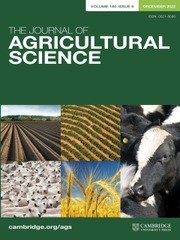Ver ítem
- xmlui.general.dspace_homeCentros e Institutos de InvestigaciónCIAP. Centro de Investigaciones AgropecuariasInstituto de Fisiología y Recursos Genéticos VegetalesArtículos científicosxmlui.ArtifactBrowser.ItemViewer.trail
- Inicio
- Centros e Institutos de Investigación
- CIAP. Centro de Investigaciones Agropecuarias
- Instituto de Fisiología y Recursos Genéticos Vegetales
- Artículos científicos
- Ver ítem
Tiller population dynamics and self-thinning law reveal stability mechanisms in mixed grass swards under variable grazing management
Resumen
Grazing management is an important component affecting pasture stability, but the underlying demographic mechanisms remain poorly understood in mixed-species systems. This three-year study investigated how grazing height (15 cm and 20 cm pre-grazing) and strategic spring defoliation (7 cm) influence stability in mixed pastures composed of complementary C3/C4 grasses (Lolium arundinaceum and Cenchrus clandestinus). Utilizing demographic and tiller
[ver mas...]
Grazing management is an important component affecting pasture stability, but the underlying demographic mechanisms remain poorly understood in mixed-species systems. This three-year study investigated how grazing height (15 cm and 20 cm pre-grazing) and strategic spring defoliation (7 cm) influence stability in mixed pastures composed of complementary C3/C4 grasses (Lolium arundinaceum and Cenchrus clandestinus). Utilizing demographic and tiller size/density relationship theories, we examined population dynamics to better understand pasture stability. The results indicated that height management significantly affected the demographic traits with shorter grazing (15 cm) increasing tiller emergence and population density while reducing individual tiller weight. In addition, higher tiller population density (TPD) and lower tiller weight (TW) were observed in the shorter treatments. Despite these contrasting responses, the mixed pasture maintained consistent stability across treatments through compensatory relationships between tiller traits. The stability index remained close to 1 (0.956 ± 0.02) regardless of management, demonstrating robust demographic equilibrium. Individual species showed distinct seasonal stability patterns - L. arundinaceum dominating in winter and C. clandestinus in spring and summer - yet their complementary growth maintained year-round system stability. The self-thinning law effectively revealed stable size-density compensation across treatments, suggesting its utility for assessing mixed sward persistence. These findings demonstrate that mixed pastures can maintain demographic stability under varying grazing regimes through species complementarity and population-level compensatory mechanisms.
[Cerrar]

Autor
Pittaro, Gabriela;
Winter, Fábio L.;
Moncada, Valentina Y.M.;
Sbrissia, André F.;
Fuente
The Journal of Agricultural Science: (Published online: 26 February 2025)
Fecha
2025-02-26
Editorial
Cambridge University Press
ISSN
0021-8596
1469-5146
1469-5146
Formato
pdf
Tipo de documento
artículo
Palabras Claves
Derechos de acceso
Embargado
 Excepto donde se diga explicitamente, este item se publica bajo la siguiente descripción: Creative Commons Attribution-NonCommercial-ShareAlike 2.5 Unported (CC BY-NC-SA 2.5)
Excepto donde se diga explicitamente, este item se publica bajo la siguiente descripción: Creative Commons Attribution-NonCommercial-ShareAlike 2.5 Unported (CC BY-NC-SA 2.5)


